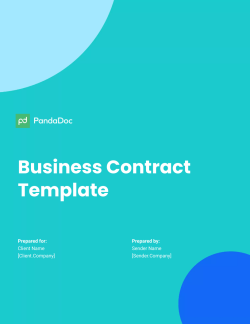
From employment and sales agreements to the various types of legal documents required by operational necessity, well-written business contracts are critical to your financial success.
Legally binding agreements can be overwhelming if you’re unfamiliar with them, especially when you need to write one for yourself or for your company.
In this article, we’ll walk you through all the details you should consider when writing a business contract.
Contract law can be tricky, and signing any legally binding document comes with some risk. This guide isn’t intended as legal advice, and you should always consult a business lawyer or a law firm when signing or creating contracts for business use.

Business Contract Template
Used 9440 times
3.9 rating (24 reviews)
Before you start creating a contract or binding agreement, take a moment to determine the type of contract that you intend to write and why you need one.
Binding contracts are essential for business deals, but the type of contract you need to create will heavily impact the terms you’ll need and the language you should use.
Let’s say you need to create an employment agreement, the terms of the contract will be vastly different from intellectual property agreement or a sales contract.
Remember: Contracts exist to fully outline the nature and terms of a mutual partnership or arrangement.
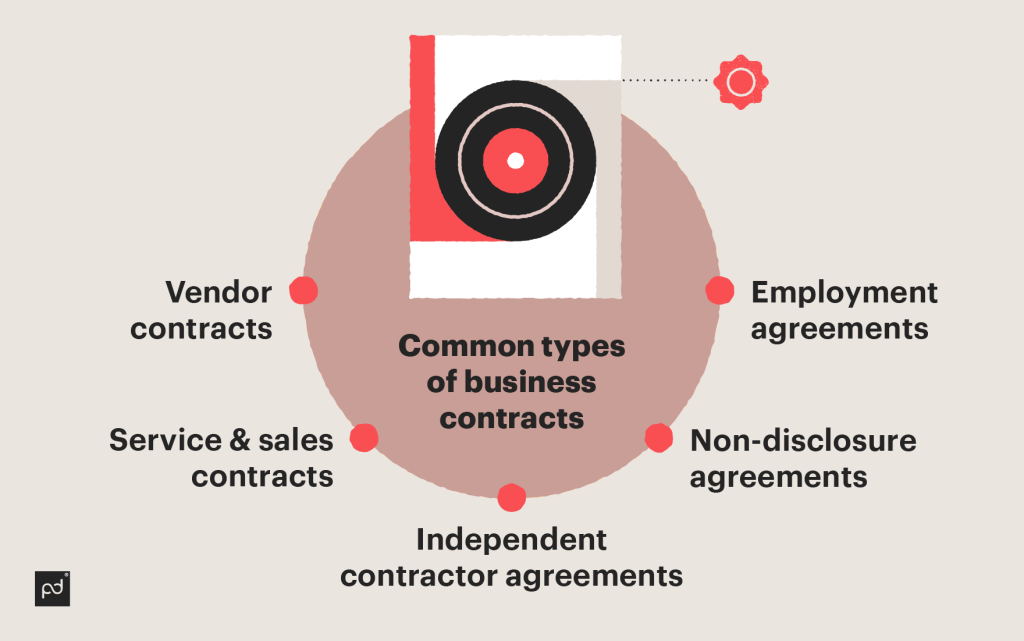
While a business might issue thousands of contracts over its lifetime, many of those contracts will fall into a few basic categories:
Once you know the type of a contract you need, you can take additional steps to further express the terms of the agreement.
You’ll also need to provide additional details regarding the nature of the work to be done and how to proceed if something goes wrong.
Set these guidelines clearly so that all involved parties are working from the same playbook to prevent any misunderstanding or disagreement.
And don’t worry about creating a written contract from scratch. Once you have a rough idea of what you need, start browsing templates that match your use case.
Take cues from existing formats and layouts that match the look and feel of the contract you need to create.
Legally speaking, you’ll need to know exactly which parties are involved in any contracting deal.
Whether you create a contract for an individual or an organization, take the time to collect all of the information before generating your contract.
Some essential details you’ll need to know:
While we’ll discuss the essential elements of a contract in the next section, you’ll need to make sure that all of the basic information is out of the way before you begin to generate your contract.
This is true regardless of whether you’re creating a lease agreement for real estate or a service agreement with a vendor partner.
You’ll also need to ensure that the individual signing the contract can function as a legal representative of the entity or organization that needs to sign your contract.
In the event that legal action is needed because of a breach of contract, ensuring the signer was authorized to do so can help to eliminate questions about the authenticity and intent of the contract.
While contractual agreements can vary greatly in scope, all contracts must be set up using a few essential elements.
These components are required for any legal contract, as they define the nature of the business relationship, the terms of the agreement, and the intent for both parties to operate under the terms of the deal.
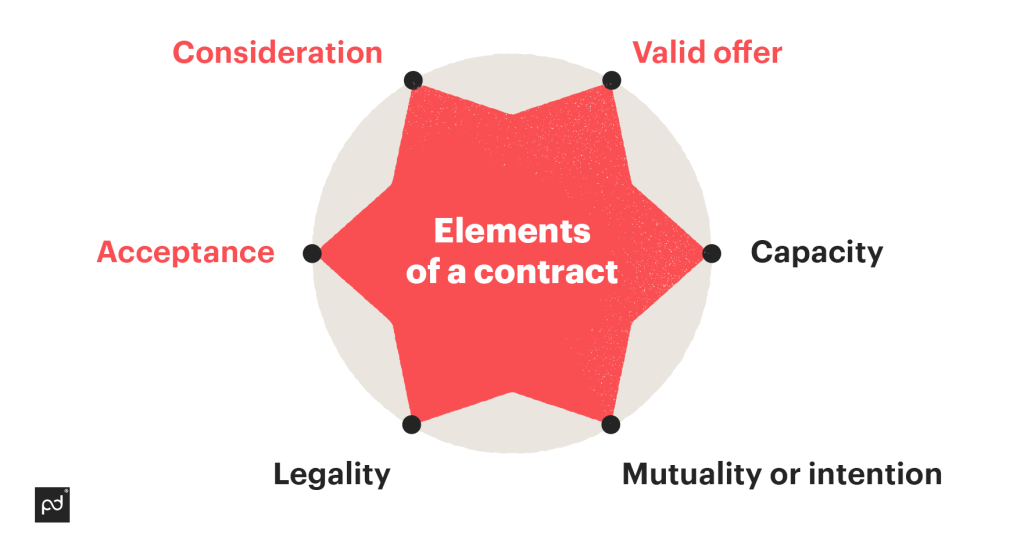
In order to create a valid contract, you’ll need to include each of the following:
While the above elements are essential to the contract itself, you’ll need to ensure that the following elements are also true.
Whether you’re writing your own contract or reading through a contract you received, all the essential elements should be plainly visible.
All of these guidelines apply to oral agreements, as well.
Unfortunately, it’s far more difficult to prove mutuality or intent with an oral agreement, which is why written contracts are highly recommended for contract lifecycle management — particularly in business scenarios.
Keep conversations moving with contract management software that works at your speed.
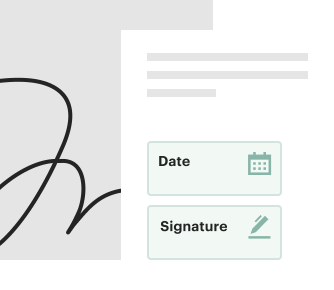
When writing your contract, you’ll automatically be subject to any federal regulations.
However, state laws and local jurisdictions may interpret some parts of your contract differently, and you can add a provision to your contract that dictates which state’s laws will be applied to the contract.
For many smaller businesses, your choice of law provision will probably be the location of your home state or corporate office.
You can also decide the jurisdiction where disputes will be handled, and the jurisdiction can be different from the law that governs the contract.
For example, the jurisdiction for resolution could be in Texas while New York law governs the contract.
If you choose to include these provisions, make sure that you are familiar with the legal landscape and are able to properly navigate contract compliance before you decide.
Keep in mind that a court might overrule these provisions if they bear no clear connection to the deal or the parties involved.
While complex legalese might be a favorite of lawyers and clickwrap agreements, it’s not required to create a workable contract.
In fact, overly complex language can be a roadblock to progress, since both parties must review and understand the agreement prior to signing.
With that in mind, when writing legal contracts for small businesses, use plain language that your clients and fellow business owners can understand.
Not only will this help to expedite deals; but it also adds a layer of transparency to your agreements.
Here are a few quick tips:
In other words, keeping key contract terms clear and unambiguous serves everyone’s interest.
The terms of your agreement can still be ironclad, but customers shouldn’t need a step-by-step guide on how to read contracts in order to make sense of your legal documentation.
Always write with your customer in mind, and try to write something that would make sense to you if you wanted to reach an agreement between you and your own company.
As mentioned above, the variety of contracts is likely to remain quite small despite the number of contracts that you issue.
Once you have a standard sales contract, a basic employment agreement, and/or other essential paperwork that speaks to your business needs, you’ll want to create a document template and then recycle that contract in scenarios where similar action needs to be taken.
You can take advantage of this operational repeatability in a few separate ways, including:
The easiest way to create a repeatable document is by creating a document template.
You just need to duplicate an existing contract and strip out all customer-specific information.
If you close dozens of sales contracts on a monthly basis, using a template already packed with a standardized set of terms and agreed-upon language will greatly expedite the progress of your deal.
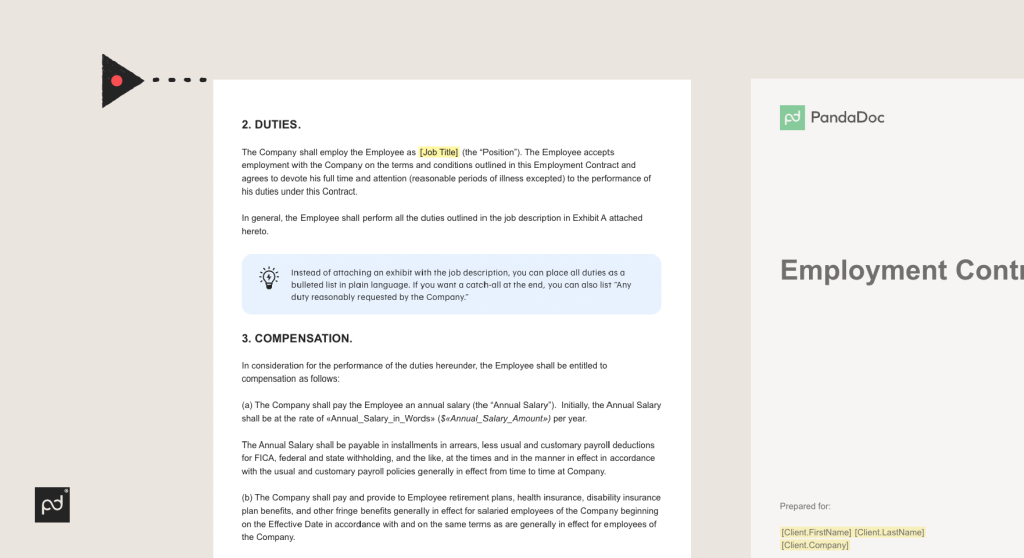
When it’s time to create a contract, you simply fill in all the relevant details and send the contract to its intended recipient.
This can be done even faster by using document variables inside a document builder.
Simply change the name in the variable in one location, and the variable will update across the entire document.
An employment contract is a great use case for a contract template and variable.
In this scenario, [Job Title] is a variable. You’ll need to fill that in prior to having the employee sign the document.
However, the rest of the language is written broadly enough that it could apply to any job duty or position.
Aside from changing a few variables to make it relevant to a specific individual, this contract is ready to go.
With more than 85,000 PandaDoc accounts using contract templates for different business needs, it’s the perfect time to make generating contracts easy for you and your team.

Sometimes, you might need to include small addendums to a contract on an as-needed basis.
Creating small blocks of content that you can drag and drop into a document at a moment’s notice can be far easier to manage than multiple documents that say roughly the same thing.
You can manage these in a spreadsheet or a Word document if you prefer — if using the latter, our DocX Converter is available to speed up workflow by converting .docx files into editable documents or templates.
Furthermore, the content library makes it easy to save everything from basic text snippets to full-blown formats and layouts.
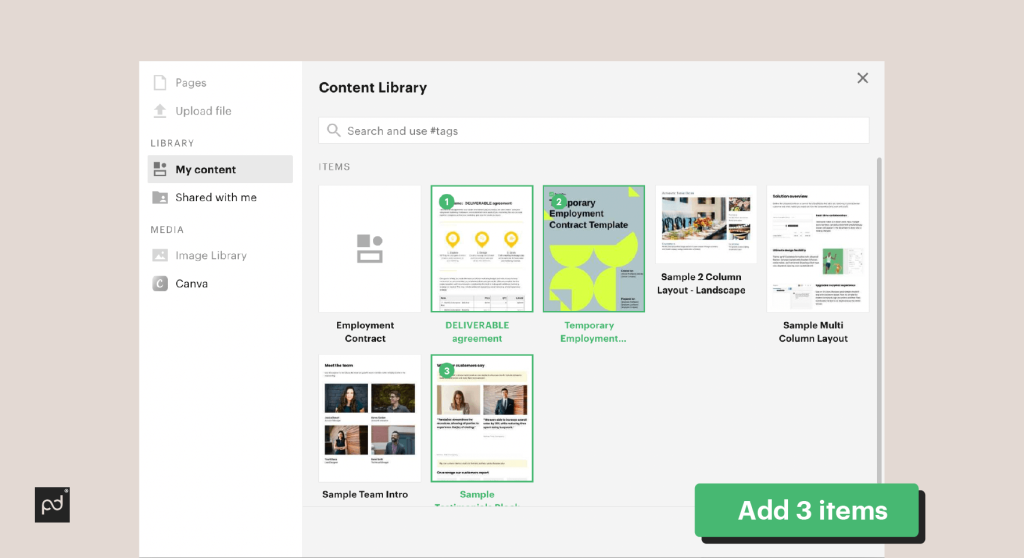
This is a great option when you need to build complex documents or if you need to adjust an existing contract on the fly.
While this approach is more granular than a dedicated template, it provides a unique level of flexibility in control of the document creation process, and that can really matter when deadlines are tight.
While you’ll need to use words to explain many of your terms and conditions, don’t forget to use other tools at your disposal when the opportunity arises.
Sometimes, a pricing table is more accurate and concise than a long-winded block of text.
A numbered or bulleted list can make your document more approachable and easier to read.
A form can help you quickly capture and organize important information.
You could use these tools to quickly create any of the following:
Because the inputs for the tables change, it’s best to set these up as flexible elements inside your document that can be easily adjusted.
Make sure that your tables can support additional rows when you need to add line items and that your formatting won’t break if the list is too small.
Use a document creation tool, to permanently solve this problem.
It’s never ideal when a job falls apart, but disputes and disagreements can happen when the scope of work is unclear or deadlines haven’t been met.
Your contract should offer clear guidelines to reach a resolution in case of such a dispute.
While these matters can be decided in a court of law, it’s often better to rely on arbitration rather than proceeding to a lengthy and expensive court battle.
You can set most of this up as part of a termination clause, an arbitration clause (or a similar ADR solution), or an indemnification agreement.
But ensure you have a clear path forward so that both parties know how to proceed in the event of a dispute that can’t be reasonably resolved.
And when everything is going well and both parties are satisfied with the arrangement, having a path forward for easy renewal is a great way to retain existing partnerships.
When that’s the case, consider having automated contract renewals or a renewal clause that allows for fast and easy renegotiation for an extended period of partnership.
Without a doubt, payments and invoicing schedules are one of the most important elements of a contract.
When writing, use all the tools we’ve discussed so far to ensure that all parties know when payments are due, who should be paid, and how much they owe.
There is some flexibility here. Payment may be contingent upon hours worked, requiring your company to send an invoice.
If your contract is set up by milestone, you may need to finish up an existing set of tasks before payment is released.
One tool to use in conjunction with building variations of contracts for different clients is adding fillable fields to your docs as appropriate.
For example, for some contracts, items could be assigned to be read; with others, fields are required to be filled out — like specific milestones — in order to finalize the contract.
Remember: Consideration in exchange for services is an essential element of your contract.
The payments listed in your contract should be directly related to the goods or services offered by the other party.
However, if you choose to level up your operation, be clear about what should happen when those conditions are met.
The contract can also stipulate late payment fees and similar penalties for lack of payment.
This can incentivize payments and work to be completed in a timely fashion.
If you choose to impose penalties for missed deadlines and late payments, take care to make clear what is and isn’t covered under such clauses and in what circumstances they are likely to apply.
Confidentiality clauses and non-compete agreements have become standard fare in many employment contracts and business arrangements.
Before you decide to write a business contract including these components, take a moment to consider whether your contract should include one.
Most essential job roles won’t require a confidentiality agreement, and the rules around non-compete agreements can make them almost impossible to enforce beyond a very specific set of circumstances.
It’s very easy to write NDAs and non-competes that are overly broad or won’t withstand scrutiny when put to the test.
While there are situations where having this documentation is essential, it might be best to leave it out of your standard contracts unless you have a good reason to do so.
You might consider adding NDAs and non-competes as an addendum to your standard contract or as a content snippet that can be added when certain criteria are met.
Issuing this type of documentation as part of each and every contract could potentially damage the credibility of your claim in the event you ever tried to enforce it.
Proof of acceptance and the intent to enter into a legal agreement are two major factors in determining the validity of a contract.
While oral contracts can be legally binding, they are much harder to enforce due to these two issues.
The opposing party could simply claim that they never intended to enter into an agreement and, without a written agreement, the terms of their obligation become unclear.
Written contracts eliminate this confusion by providing all the details and stipulations of the agreement. However, you’ll still need proof of acceptance.
In other words, both parties need to sign the document.
Signing can be done using pen and ink, but consider using e-signature for the best experience and results for all involved parties.
Going electronic not only saves trees — it allows for a faster negotiation process.
Plus, if you’re using collaboration tools with the ability to approve workflows in real time, you’ll have a list of changes so that you can see the history of the document and how it has evolved.
Furthermore, e-signatures verify the authenticity of the signer and offer proof that your contract was signed by the appropriate parties.
E-signing is a simple solution that defends against contract repudiation, denial that the contract was signed or that no deal was made — all because the terms offered, the proof of signature, and evidence of the intent to enter into a contract are digitally stored.
More than 99,000 PandaDoc accounts have already used the e-signature at least once. Ready to join the club?

Looking for some inspiration when creating your own contracts?
PandaDoc offers over 1000+ templates as part of our template gallery to help you get started!
And don’t forget to check out our community gallery, where customers have submitted top-performing templates that you can use.
Below, you’ll find a few of our favorite and most accessible templates.
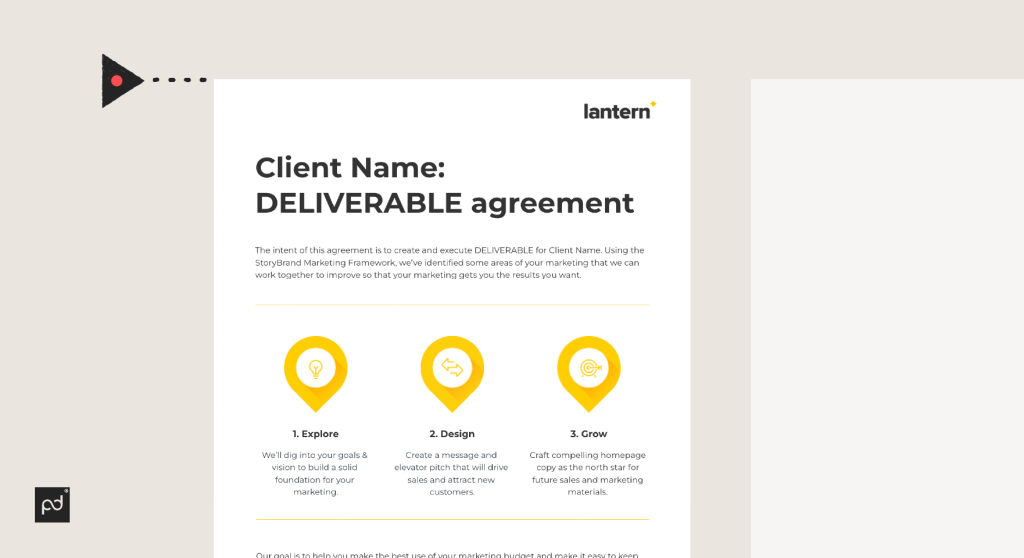
This short and simple deliverable agreement allows sales reps to quickly assess what needs to be done for a client and offer recommended solutions.
The agreement relies heavily on a pricing table, which details the selected work, the quantity, and the estimated cost.
Behind the scenes, users can take advantage of the product catalog to quickly add items to the table.
At the bottom, you’ll see a place for signatures, specifications for the parties involved, information about payment schedules, and details regarding the nature of the agreement.
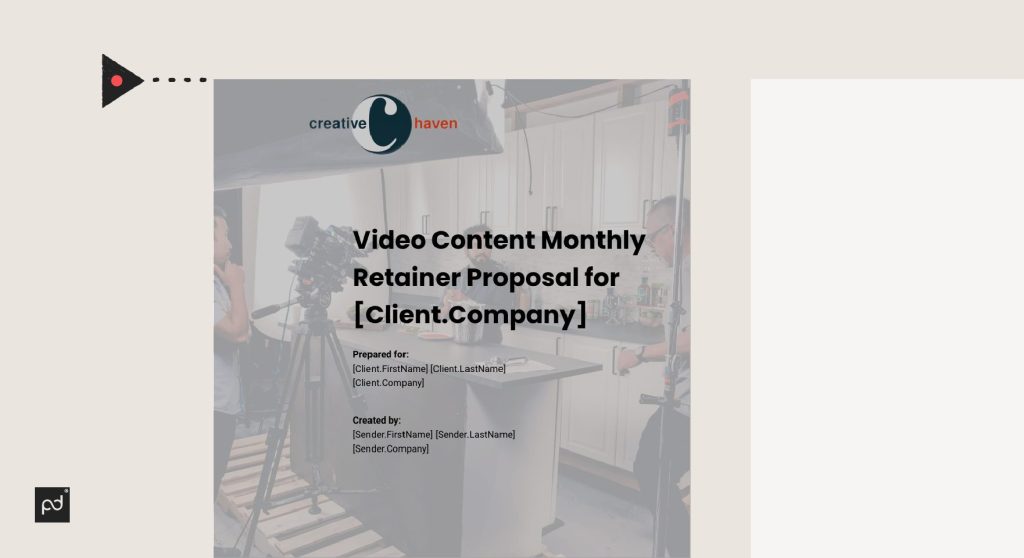
This is a video marketing proposal aimed at food companies and features in-depth details regarding their products, services, and solutions.
The top half of the document outlines products and services at a general level.
Halfway down, it becomes more specific by offering a recommended solution and a pricing table to indicate costs.
The information in the table and the associated cost would clearly indicate the offer and expected consideration.
While this appears to be a sales proposal at first, note the General Services Agreement in the bottom half of this document.
This, combined with the plans and pricing section and the cost estimates give his proposal all the hallmarks of a contract.
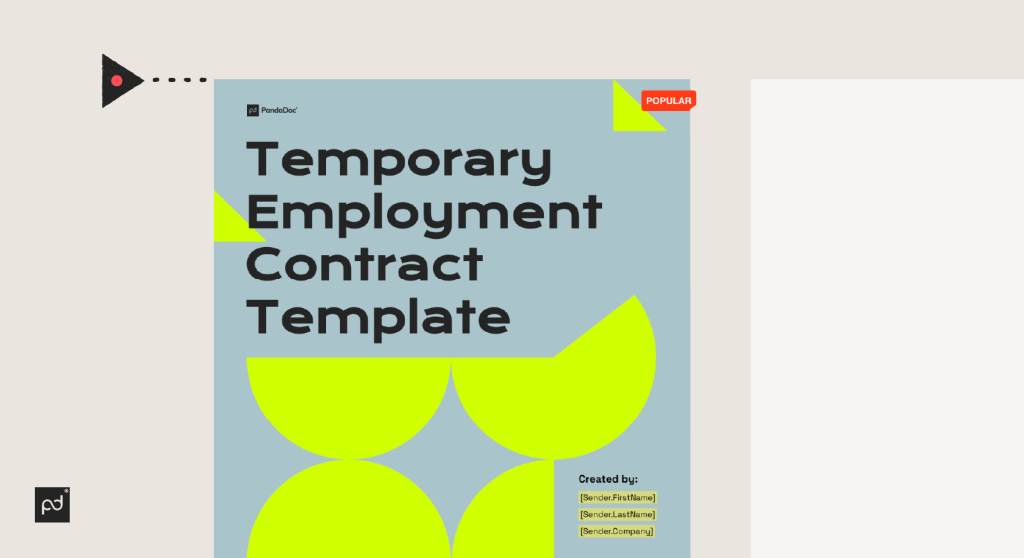
This contract outlines all the basic details for hiring a temporary employee.
Scrolling through, you’ll see clearly defined sections for terms, termination, duties, hours, and more.
This boilerplate contract relies heavily on attached documentation (referred to as Exhibits in the document) to better outline the more pertinent information for the temp worker.
Bundled together, the exhibit documentation and the standardized contract create something that is both generic and open-ended enough to be a template and flexible enough to be easily customized.
Even if you have all the knowledge at your disposal, writing a contract from scratch can be a major challenge.
After you’re done, you’ll also need to get it to the right people, manage negotiations, and get everyone to sign on the dotted line.
That’s a tall order for any one person. Fortunately, PandaDoc has got you covered.
Our platform is designed to expedite contract negotiation, streamline your quote-to-cash cycle, and make sure that every document you send is safely and securely signed.
This includes the bulk send feature that allows you to send required documents to up to 1,000 customers at once, and effortlessly track when recipients have opened and e-signed each one of them.
Streamline contract creation and management with our winning combination of template library and community gallery, bulk document sending, management, and e-signature functionality — schedule a 15-minute demo today.
Certainly. You don’t need to be a lawyer in order to write your own contract. There are plenty of great resources, templates, and examples that can help you create basic contracts from scratch. Keep in mind that contracts can be challenging. Even if you write a contract by yourself, consider seeking a second set of eyes from a lawyer to ensure that it’s legal, enforceable , and doesn’t open your organization to unwanted exposure.
The first step is to determine the purpose of the contract. Once you know what the contract is intended to do, specify the terms of the agreement and write down all necessary details required. Be sure to list all appropriate parties and provide a clear and convenient way for all stakeholders to negotiate and sign your contract.
In addition, all parties must show an intent to enter into a contract and have the mental capacity and legal authority to do so.
You can also customize your contract with additional guidance or regulations, including the state law that should govern the contract, what happens if a dispute arises, and whether the information provided from the resulting agreement should be kept confidential.
No, but it’s still a good idea to have your contract reviewed by legal counsel who specializes in the governing law of your contract to ensure that everything is enforceable and above board. You will almost certainly benefit from a consultation with a legal team that specializes in areas where you’ll be subject to industry regulations and compliance issues.
If you’ve already written your contract, congratulations! Next, you should review it with legal counsel if you intend to do so. After the contract is finalized, make a template so that you can reuse it in the future. When it’s time to sign, we’d recommend uploading the document to an e-signing platform like PandaDoc and sending it to clients for review. Once the document is signed, your contract is finished and you’re ready to move forward!
Legally speaking, traditional proposals and contracts are seen as two separate entities. However, like agreements, the word “proposals” can sometimes be used interchangeably with “contracts.” If the language of the proposal includes all the elements of a contract (listed above), along with indications that you should sign it and make a payment, you’re probably looking at a contract.
PandaDoc is not a law firm, or a substitute for an attorney or law firm. This page is not intended to and does not provide legal advice. Should you have legal questions on the validity of e-signatures or digital signatures and the enforceability thereof, please consult with an attorney or law firm. Use of PandaDocs services are governed by our Terms of Use and Privacy Policy.
Originally published October 11, 2022 and has been updated April 23, 2024
Hanna Stechenko Manager, SEO Management
Hanna Stechenko is a Manager, SEO Management at PandaDoc. Hanna is responsible for the company's SEO Content strategy, ensuring that the company's website ranks high in search engine results. She keeps up with SEO trends, which helps her connect real people with relevant messages.
Reviewed byKeith Rabkin Chief Revenue Officer for PandaDoc
Keith has been working in technology organizations for the past 15 years and is currently the Chief Revenue Officer for PandaDoc. Prior to this, he had roles leading Growth for Adobe's Digital Media business, Gmail, YouTube, and Google Fiber.
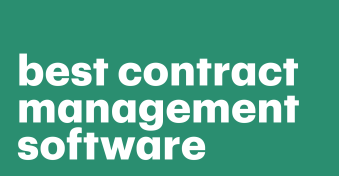


Subscribe to get our most-popular proposal eBook and more top revenue content to help you send docs faster.